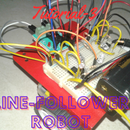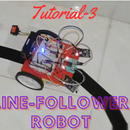Introduction: Flip-Flops Using Discrete Transistors
Hello everyone,
Now we are living in the world of digital. But what is a digital ? Is is far away from analog ? I saw many people, which believes that the digital electronics is different from analog electronics and the analog is a waste one. So here I made this instructable to aware people which believes that digital is different from analog electronics. In reality the digital and analog electronics are same, the digital electronics is only a small portion of analog electronics like electronics in the physics world. The digital is a limited condition of analog. Basically the analog is better than the digital, because when we convert analog signal into digital its resolution decreases. But today we use the digital, it is only because the digital communication is simple and less interference and noisy than the analog. The storage of digital is simple than the analog. From this we get that, The digital is only a subdivision or a limited condition of analog electronics world.
So in this instructable I made the basic digital structures like flip-flops using discrete transistors. I believe that this experience definitely think you different. OK. Lets start it...
Step 1: What Is Digital ???
Digital is nothing, It is only a way for communication. In digital we represent all the data in ones (high voltage level in the circuit or Vcc) and zeros (low voltage in the circuit or GND). But in digital we represent the data in all the voltages between the Vcc and GND. That is, it is a continuous one and the digital is discrete one. All the physical measurements are in continuous or analog. But now a days we analyse, compute, store this data only in digital or discrete form. It is because it has some unique advantages like noise immunity, less storage space etc..
Example for digital and analog
Consider a SPDT switch, Its one end connected to Vcc and other to GND. When, we move the switch from one position to other then we get an output like this Vcc, GND, Vcc, GND, Vcc, GND,...This is the digital signal. Now we replace the switch by a potentio-meter (variable resistor). So, when rotate the probe then we get a continuous voltage change from GND to Vcc. This represent the analog signal. OK, got it...
Step 2: Latch
Latch is the basic memory storing element in the digital circuits. It store one bit of data. It is the smallest unit of data. It is a volatile type of memory because its stored data vanishes when power failure occurs. Only store the data until power supply is present. Latch is the basic element in every flip-flop memories.
The above video shows the latch which wired on a breadboard.
The above circuit diagram shows the basic latch circuit. It contains two transistors, each transistor base is connected to others collector for get a feedback. This feedback system help to store the data in it. The external input data is provided to the base by apply the data signal to it. This data signal override the base voltage and the transistors move to next stable state and store the data. So it is also known as bi-stable circuit. All the resistors provided to limit the current flow to the base and the collector.
For more details about the latch, visit my blog, link given below,
https://0creativeengineering0.blogspot.com/2019/03/what-is-latch.html
Step 3: D Flip-flop & T Flip-flop : Theory
These are the commonly used flip-flops now a days. These are used in most of the digital circuits. Here we discuss about its theory part. Flip- flop is the practical memory storing element. The latch is not used in circuits, only use the flip -flops. The clocked latch is the flip-flop. The clock is an enabling signal. Only the flip-flop read the data at the input when clock is in the active region. So the latch is converted to flip-flop by adding a clock circuit in front of the latch. These are different type level triggering and edge triggering. Here we discuss about the edge triggering because it is mostly used in digital circuits.
D flip-flop
In this flip-flop the output is copies the input data. If input is 'one' then output is always 'one'. If input is 'zero' then output always 'zero'. The truth table given in the image above. The circuit diagram indicate the discrete d flip flop.
T flip-flop
In this flip-flop the output data do not change when input is at 'zero' state. The output data toggles when the input data is 'one'. That is 'zero' to 'one' and 'one' to 'zero'. The truth table given above.
For more details about flip flops. Visit my blog. Link given below,
Step 4: D Flip-Flop
The above circuit diagram shows the D flip-flop. It is a practical one. Here the 2 transistors T1 and T2 are work as latch (previously discussed) and the transistor T3 is used for drive the LED. Otherwise the current drawn by the LED changes the voltages at the output Q. The fourth transistor is used to control the input data. It passes the data only when it's base is at high potential. It's base voltage is generated by the differentiator circuit created by using capacitor and resistors. It convert the input square wave clock signal to sharp spikes. It create the transistor to on at an instant only. This is the working.
The video shows its working and theory.
For more details about its working, Please visit my BLOG, link given below,
https://0creativeengineering0.blogspot.com/2019/03/what-is-d-flip-flop-using-discrete.html
Step 5: T Flip-Flop
The T flip-flop is made from D flip-flop. For this, connect the data input to the complementary output Q'. So It's output state change automatically (toggles) when clock is applied. The circuit diagram is given above. The circuit contain an extra capacitor and a resistor. The capacitor is used to introduce a lag between the output and input (latch transistor). Otherwise it don't works. Because we connect the transistor output to it's base itself. So don't works. It works only when the two voltages has a time lag. This lag is introduce by this capacitor. This capacitor is discharges by using the resistor from the Q output. Other wise it don't toggles. The Din connected to the complementary output Q' for provide the toggle input signals. So by this process this works very well.
For more details about circuit, please visit my BLOG, link given below,
https://0creativeengineering0.blogspot.com/2019/03/what-is-t-flip-flop-using-discrete.html
The above video also explain its working and it's theory.
Step 6: Future Plans
Here I completed the basic digital circuits(sequential circuits) using discrete transistors. I love the transistor based designs. I done the discrete 555 project in few months later. Here I created this flip-flops for making a discrete DIY computer using transistors. The discrete computer is my dream. So in my next project I make some kind of counters and decoder by using discrete transistors. It will coming soon. If you like it ,Please support me. OK. Thank you.
Step 7: DIY Kits
Hello, there is a happy news....
I plan to design the D and T flip-flop DIY kits for you. Every electronic enthusiasts loves the transistor based circuits. So I plan to create a professional flip-flop (not prototype) for electronic enthusiasts like you. I believed that you need this. Please give your opinions. Please respond to me.
I don't create DIY kits before. It is my first planing. If you support me, definitely I make discrete flip-flop DIY kits for you. OK.
Thank you..........

Participated in the
Epilog X Contest














